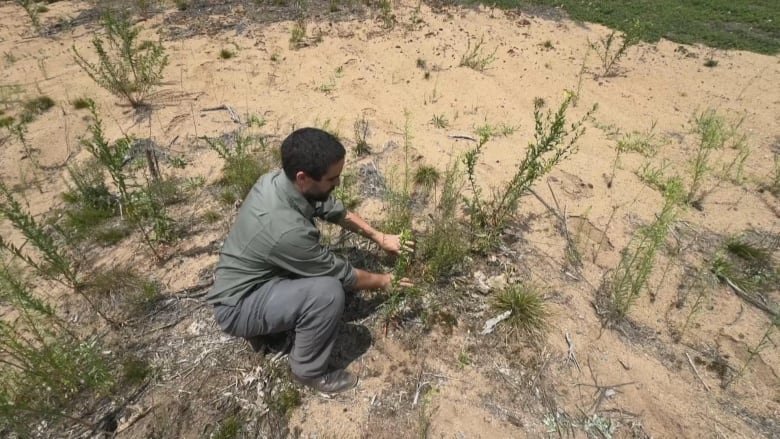Endangered rock rose plant could hold clues to protecting Nova Scotian sand barrens
New study published last month by Acadia University instructors looks into rock rose and its ecosystem
Researchers from Nova Scotia's Acadia University hope a new study on the rock rose will help them better understand the connections between the critically imperiled plant species and the sand barrens of the Annapolis Valley.
Rock rose, also known as Canada frostweed, grows in dry, sandyand acidic soil. But its natural habitat has been reduced by 97 per cent due to agriculture, transportation and housing developments, leading to massive population decline.
Kendra Sampson of Acadia's K.C. Irving Environmental Science Centre, who led the research, said she obtained seeds and sand from the plant's natural habitat and used them for propagation in the lab.
"This plant is a small piece of a larger picture," said Sampson. "We look at some individual plants, but they all make up the big goal of the mandate of maintaining biodiversity in these ecosystems."
The study found a type of fungus, arbuscular mycorrhizalfungi (AMF), formed mutually beneficial relationships with the plant's roots, aiding it in absorbing water and nutrients in the acidic soils of sand barrens.

"[AMF] form a root-like structure that's much smaller in diameter than plant roots," she said. "It extends much further in the soil and can gather up nutrients for the plants, so phosphorus or nitrogen,even acquire water for the plants."
Sampson hopes the study will assist conservationists in gaining a better understandingof the connections between species in the sand barrens and how the preservation of one species could benefit all the others.
She said the specimens she grew in the lab could be planted back into the wild, and the fungicould be used as a greenalternative to fertilizers.

The sand barrens in Annapolis Valley are extremely delicate ecosystems that depend on naturally occurring forest fires to clear tall vegetation.
The species that live there exchange nutrient-rich soil for bright sunshine, which is why AMF is important to any plant growing in this sandy, acidic soil, Sampson said.
Alain Belliveau, collections manager at Acadia's E.C. Smith Herbarium, was part of a team of specialists that developed the Nova Scotia Recovery Plan for the Rockrose in 2021.
He has been monitoring the plant and surveying its population trends every couple of years to get a sense of how the sand barrens are doing.
"A big part of it is that these plants, what we call species at risk, represent the tip of the iceberg," said Belliveau.
"The rock rose is so rare and so threatened that we look at it as representing the ecosystem as a whole."

Belliveau hopes more studies like this will improve their conservation efforts forthe rock rose and other at-risk species in the ever-rarer Nova Scotia sand barrens.
He said he would like to see the provincial government, universities and non-profits investing in more research as they are struggling to secure funding and staff.
"There's a lot of work ahead," he said.













_(720p).jpg)


 OFFICIAL HD MUSIC VIDEO.jpg)
.jpg)



























































































